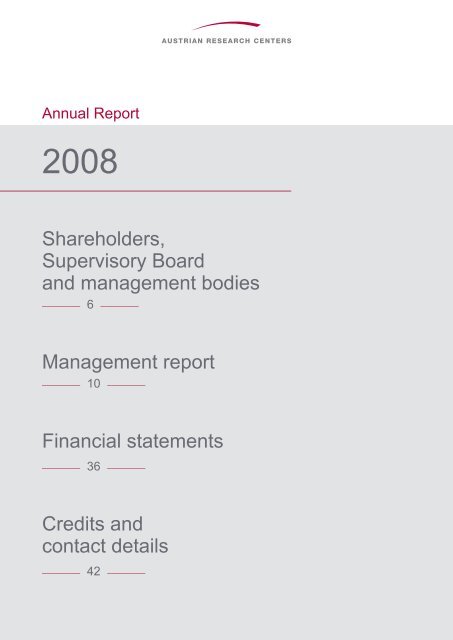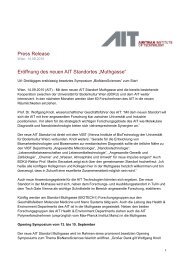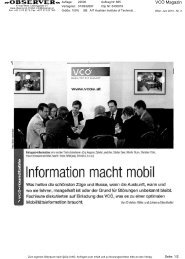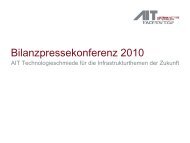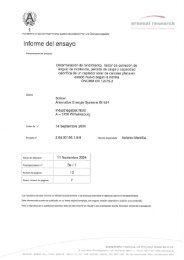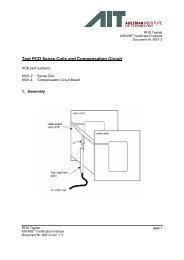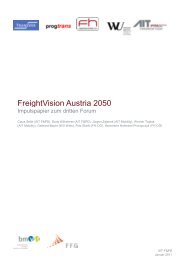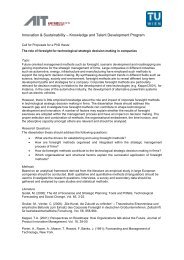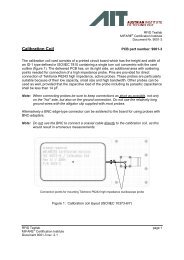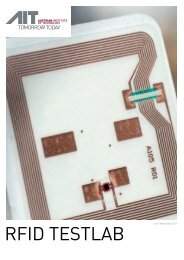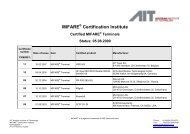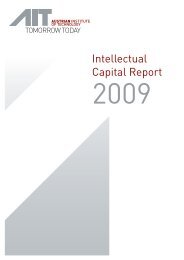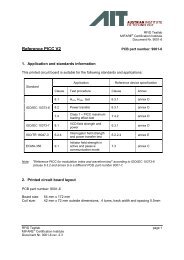Shareholders, Supervisory Board and management bodies ...
Shareholders, Supervisory Board and management bodies ...
Shareholders, Supervisory Board and management bodies ...
You also want an ePaper? Increase the reach of your titles
YUMPU automatically turns print PDFs into web optimized ePapers that Google loves.
Annual Report<br />
2008 2008<br />
<strong>Shareholders</strong>,<br />
<strong>Supervisory</strong> <strong>Board</strong><br />
<strong>and</strong> <strong>management</strong> <strong>bodies</strong><br />
––––––––– 6 –––––––––<br />
Management report<br />
––––––––– 10 –––––––––<br />
Financial statements<br />
––––––––– 36 –––––––––<br />
Credits <strong>and</strong><br />
contact details<br />
––––––––– 42 –––––––––
From ARC to AIT<br />
Austrian Institute of Technology (AIT)<br />
the Austrian research institution<br />
of European calibre<br />
Five specialist departments with a research focus on tomorrow‘s key infrastructure issues<br />
The objective of AIT‘s five departments — Mobility, Energy, Health & Environment, Safety &<br />
Security, <strong>and</strong> Foresight Policy & Development — is to give a technological lead, <strong>and</strong> develop<br />
methods <strong>and</strong> solutions for industrial <strong>and</strong> public sector clients.<br />
The new strategic thrust, ownership structure, governance system <strong>and</strong> scientific quality assurance<br />
processes at the Austrian Institute of Technology are designed to position AIT as a<br />
research institution of European calibre. This will enhance our partners’ innovative potential<br />
<strong>and</strong> strengthen Austria‘s competitive position as a business location.
00<br />
Contents<br />
Annual Report<br />
2008
Contents<br />
Section Page<br />
01 <strong>Shareholders</strong>, <strong>Supervisory</strong> <strong>Board</strong> <strong>and</strong> <strong>management</strong> <strong>bodies</strong> 6<br />
1.1 <strong>Shareholders</strong> 8<br />
1.2 <strong>Supervisory</strong> <strong>Board</strong> <strong>and</strong> <strong>management</strong> <strong>bodies</strong> 9<br />
02 Management report 10<br />
2.1 Structural report 12<br />
2.2 Business performance in 2008 26<br />
2.3 Risk report 32<br />
2.4 Outlook report<br />
Financial <strong>and</strong> non-financial performance indicators<br />
2.5 Post balance sheet date events 35<br />
03 Financial statements 36<br />
3.1 Consolidated balance sheet 38<br />
3.2 Consolidated profit <strong>and</strong> loss account 40<br />
04 Credits <strong>and</strong> contact details 42<br />
34<br />
00<br />
Annual Report 2008<br />
Contents
01<br />
<strong>Shareholders</strong>,<br />
<strong>Supervisory</strong> <strong>Board</strong><br />
<strong>and</strong> <strong>management</strong><br />
<strong>bodies</strong><br />
Annual Report<br />
2008
01<br />
Annual Report 2008<br />
<strong>Shareholders</strong>,<br />
<strong>Supervisory</strong> <strong>Board</strong> <strong>and</strong><br />
<strong>management</strong> <strong>bodies</strong><br />
As at 31. Dec. 2008<br />
01 <strong>Shareholders</strong>, <strong>Supervisory</strong> <strong>Board</strong> <strong>and</strong> <strong>management</strong> <strong>bodies</strong> Page<br />
1.1 <strong>Shareholders</strong> 8<br />
1.2 <strong>Supervisory</strong> <strong>Board</strong> <strong>and</strong> <strong>management</strong> <strong>bodies</strong> 9<br />
7<br />
Annual Report 2008
01<br />
Annual Report 2008<br />
<strong>Shareholders</strong>,<br />
<strong>Supervisory</strong> <strong>Board</strong> <strong>and</strong><br />
<strong>management</strong> <strong>bodies</strong><br />
As at 31. Dec. 2008<br />
8<br />
Annual Report 2008<br />
1.1 <strong>Shareholders</strong><br />
As at 31 December 2008<br />
A Republic of Austria (50.46%)<br />
BMVIT (Federal Ministry of Transport,<br />
Innovation <strong>and</strong> Technology)<br />
B Industry (49.54%)<br />
ABB AG<br />
Alcatel-Lucent Austria AG<br />
Allianz Elementar Versicherungs-<br />
Aktiengesellschaft<br />
APC Advanced Pollution Control AG<br />
Austria Metall Aktiengesellschaft<br />
BAWAG P.S.K. Bank für Arbeit und<br />
Wirtschaft und Österreichische<br />
Postsparkasse Aktiengesellschaft<br />
Berndorf Aktiengesellschaft<br />
BÖHLER-UDDEHOLM Aktiengesellschaft<br />
BSM Diagnostica Gesellschaft m.b.H<br />
Erste Bank der österreichischen<br />
Sparkassen AG<br />
EVN AG<br />
Gerot Pharmazeutika Gesellschaft.m.b.H<br />
GrECo International AG<br />
HENKEL CENTRAL EASTERN EUROPE<br />
GESELLSCHAFT MBH<br />
Hirtenberger Aktiengesellschaft<br />
Investkredit Bank AG<br />
KELAG-Kärntner Elektrizitäts-<br />
Aktiengesellschaft<br />
Kommunikations- & Sicherheitssysteme<br />
Gesellschaft m.b.H<br />
Mag. Dietbert Kowarik (trustee)<br />
Kwizda Holding GmbH<br />
New shareholder structure as at 25 March 2009:<br />
Austrian government 50.46%<br />
BMVIT (Federal Ministry for Transport, Innovation <strong>and</strong> Technology)<br />
Federation of Austrian Industries Verein zur Förderung von Forschung und Innovation<br />
(Association for the Promotion of Research <strong>and</strong> Innovation) 49.54%<br />
Lafarge Perlmooser AG<br />
MAGNA STEYR Fahrzeugtechnik AG &<br />
Co KG<br />
Mediscan GmbH & Co KG<br />
OMV Refining & Marketing GmbH<br />
PKE Electronics AG<br />
PLANSEE Aktiengesellschaft<br />
Siemens Aktiengesellschaft Österreich<br />
Steirische Wasserkraft- und Elektrizitäts-<br />
Aktiengesellschaft<br />
Telekom Austria TA Aktiengesellschaft<br />
T-Mobile Austria GmbH<br />
UniCredit Bank Austria AG<br />
VA TECH HYDRO GmbH<br />
Verb<strong>and</strong> der Elektrizitätsunternehmen<br />
Österreichs (Association of Austrian<br />
Electricity Companies)<br />
VERBUND-Austrian Renewable Power<br />
GmbH<br />
Vereinigung der österreichischen Industrie<br />
(Federation of Austrian Industries)<br />
voestalpine Stahl GmbH<br />
Vorarlberger Illwerke Aktiengesellschaft<br />
WBB Stahl- und Maschinenbau AG (in<br />
liquidation)<br />
WIENSTROM GmbH
1.2 <strong>Supervisory</strong> <strong>Board</strong> <strong>and</strong> <strong>management</strong> <strong>bodies</strong><br />
As at 31 December 2008<br />
<strong>Board</strong> of Management<br />
Wolfgang KNOLL<br />
Anton PLIMON<br />
Authorised signatories<br />
Josef FRÖHLICH<br />
Heinrich GARN<br />
DGeorg HABERHAUER<br />
Thomas KADI<br />
Alex<strong>and</strong>er SVEJKOVSKY<br />
Alfred WANSCH<br />
<strong>Supervisory</strong> <strong>Board</strong><br />
President<br />
Hannes ANDROSCH<br />
Vice Presidents<br />
Robert BÖHM<br />
Gerhard RIEMER<br />
from 25 July 2008<br />
Members<br />
Robert BÖHM<br />
Peter EGGER<br />
Silvia JANIK<br />
Maria KUBITSCHEK<br />
Gerhard RIEMER<br />
from 2 July 2008<br />
Norbert ROZSENICH<br />
Ingolf SCHÄDLER<br />
Peter SCHWAB<br />
Edeltraud STIFTINGER<br />
from 2 July 2008<br />
Franz VIEHBÖCK<br />
Members delegated by the Works Council<br />
Karl Heinz ASCHBACHER<br />
Karl FARTHOFER<br />
Heinrich HUMER<br />
Philip LEOPOLD<br />
Rudolf ORTHOFER<br />
Eva WILHELM<br />
Scientific Advisory <strong>Board</strong>s<br />
NES<br />
Helmut BÖCK (Chairman)<br />
Kathrin EBERL-SVOBODA<br />
Brigadier Norbert FÜRSTENHOFER<br />
Viktor KARG (stellvertretender Vorsitzender)<br />
Wolfgang PFEIFER<br />
Jirina RADY<br />
Horst REICHER<br />
Silvia VARGA<br />
Gabriele VOIGT<br />
All other advisory boards <strong>and</strong> the holding company advisory board were dissolved at the end of 2008.<br />
01<br />
Annual Report 2008<br />
<strong>Shareholders</strong>,<br />
<strong>Supervisory</strong> <strong>Board</strong> <strong>and</strong><br />
<strong>management</strong> <strong>bodies</strong><br />
As at 31. Dec. 2008<br />
9<br />
Annual Report 2008
02<br />
Management report<br />
Annual Report<br />
2008
02 Management report Page<br />
2.1 Structural report 12<br />
2.2 Business performance in 2008 26<br />
2.3 Risk report 32<br />
2.4 Outlook report<br />
Financial <strong>and</strong> non-financial performance indicators<br />
2.5 Post balance sheet date events 35<br />
34<br />
11<br />
Annual Report 2008
02<br />
Annual Report 2008<br />
Management report<br />
Structural report<br />
12<br />
Annual Report 2008<br />
2.1 Structural report<br />
2.1.1 Strategic realignment of Austrian Research Centers (ARC)<br />
The 2008 financial year witnessed a wide-ranging realignment of Group structures <strong>and</strong> activities<br />
at ARC. Under the stewardship of Managing Directors Anton Plimon (appointed as Chief Executive<br />
Officer on 1 April 2008) <strong>and</strong> Wolfgang Knoll (Chief Research Officer since 1 April 2008), a<br />
comprehensive change process was introduced <strong>and</strong> a raft of other measures were taken.<br />
The organisational <strong>and</strong> strategic changes were accompanied by a simplification of the ownership<br />
structure. 2008 thus marked the starting point for an complete repositioning of Austrian Research<br />
Centers.<br />
The new Austrian Institute of Technology (AIT) which has emerged from ARC will focus on<br />
improving efficiency by means of restructuring <strong>and</strong> spin-offs, on new fields of research <strong>and</strong> on the<br />
development of a new governance system. To this end, in 2008 Austrian Research Centers laid<br />
the foundations for significant changes in the future portfolio, the organisational structure <strong>and</strong> the<br />
institution’s role in the domestic <strong>and</strong> international innovation systems.<br />
2.1.2 Ownership structure<br />
The process of streamlining the ownership structure was initiated in 2008. The assignment<br />
procedures notified by the Company by way of the contract of assignment signed on 18 December<br />
2008 were registered on 25 March 2009, following an application to the register of companies filed<br />
on 23 March 2009. As a result, the shareholders as of the reporting date were as follows:<br />
Austrian government (Ministry of Transport, Innovation <strong>and</strong> Technology);<br />
Federation of Austrian Industries (Association for the Promotion of Research <strong>and</strong> Innovation).<br />
2.1.3 Organisational structure <strong>and</strong> research focus<br />
The new organisational structure of the ARC Group is shown in the organisational chart below.<br />
The new structure came into effect on 12 January 2009. It is derived from the four existing strategic<br />
divisions: Health Technologies, Materials Technologies, Information Technologies <strong>and</strong> Mobility &<br />
Energy. In future, our strategic research thrusts will be the responsibility of five departments: Foresight<br />
& Policy Development, Health & Environment, Safety & Security, Mobility, <strong>and</strong> Energy.<br />
Additional structural changes in 2008 resulted from the sale of some operations of the Research<br />
Studios Division to Research Studios Austria Forschungsgesellschaft mbH (34 employees) with<br />
effect from 1 June 2008 <strong>and</strong> to EOX-IT Services GmbH (four employees) as of 2 July 2008. The<br />
continued operation of ECHEM GmbH — a former Kplus competency centre with 38 employees —<br />
was assured by its partial sale to CEST GmbH. The latter is a K1 centre financed under the FFG<br />
(Austrian Research Promotion Agency) COMET programme.<br />
These disposals marked a major advance towards streamlining ARC’s strategic portfolio, <strong>and</strong><br />
aligning its activities with its new organisational structure <strong>and</strong> objectives. The change of name<br />
from Austrian Research Centres to Austrian Institute of Technology (AIT) will serve to highlight the<br />
Company’s transformation.
02<br />
Annual Report 2008<br />
Management report<br />
Structural report<br />
13<br />
Annual Report 2008
02<br />
Annual Report 2008<br />
Management report<br />
Organisational Structure<br />
As at 31. Dec. 2008<br />
14<br />
Annual Report 2008<br />
Corporate service functions<br />
Department<br />
Foresight & Policy<br />
Development<br />
Unit<br />
Technology Policy<br />
Unit<br />
Spatial Systems<br />
Unit<br />
Technology Management<br />
Auditing<br />
Department<br />
Health & Environment<br />
Unit<br />
Environmental Resources &<br />
Technologies<br />
Unit<br />
Bioresources<br />
Unit<br />
Molecular Medicine<br />
Unit<br />
Biomedical Systems<br />
Unit<br />
Nano Systems<br />
Austrian Research Centres (ARC)<br />
<strong>Board</strong> of Management<br />
Department<br />
Corporate <strong>and</strong> Legal Services<br />
Department<br />
Safety & Security<br />
Unit<br />
Quantum Technologies<br />
Unit<br />
Video <strong>and</strong> Security<br />
Technology<br />
Sub-division<br />
Neuroinformatics<br />
Unit<br />
High-Performance<br />
Image Processing<br />
Unit<br />
Save <strong>and</strong> Autonomous<br />
Systems<br />
Unit<br />
Information Management &<br />
e-Health
Department<br />
Finance & Controlling<br />
Department<br />
Mobility<br />
Unit<br />
Electric Drive Technologies<br />
Unit<br />
Transportation Infrastructure<br />
Technologies<br />
Unit<br />
Dynamic Transportation<br />
Systems<br />
Subsidiary<br />
Light Metal Competence<br />
Center (LKR)<br />
Department<br />
Energy<br />
Unit<br />
Sustainable Thermal<br />
Energy Systems<br />
Unit<br />
Electric Energy Systems<br />
Unit<br />
Sustainable Building<br />
Technologies<br />
Subsidiary<br />
arsenal research<br />
* The former AMAT Division will continue to exist with the previous organisational structure.<br />
Unit<br />
Infrastructure Certification<br />
Subsidiary<br />
02<br />
Annual Report 2008<br />
Management report<br />
Organisational Structure<br />
As at 31. Dec. 2008<br />
arsenal research<br />
Nuclear Engineering<br />
Seibersdorf GmbH<br />
Subsidiary<br />
Seibersdorf Labor GmbH<br />
Subsidiary<br />
ISS Beteiligungsges. mbH<br />
Business unit<br />
Technology Transfer Centre<br />
(TTZ) Leoben<br />
Business unit<br />
Portfolio to be defined*<br />
15<br />
Annual Report 2008
02<br />
Annual Report 2008<br />
Management report<br />
Structural report<br />
16<br />
Annual Report 2008<br />
2.1.4 Strategic positioning <strong>and</strong> development of research areas<br />
AIT’s strategic focus on infrastructure reflects the central importance of this field for industry <strong>and</strong> the<br />
public sector. The public sector itself is a key investor in transportation, energy, health, security <strong>and</strong><br />
innovation infrastructure, <strong>and</strong> consequently has an important role to play in innovative procurement<br />
<strong>management</strong>. At the same time the development of innovative industrial solutions with a strong<br />
systems orientation calls for an environment that is conducive to top quality research <strong>and</strong><br />
development.<br />
In recognition of this the Austrian Institute of Technology will present itself as a highly specialised<br />
R&D partner in its selected fields of technology. Its activities in these areas will focus on developing<br />
technologies, methodologies <strong>and</strong> processes that will generate leading-edge innovations with an<br />
implementation timeframe of five years or more. AIT will also act as a central node in the European<br />
innovation network with outst<strong>and</strong>ing foresight capabilities.<br />
A cornerstone of AIT’s future work will be the ability to agree multi-year budgets with the Ministry.<br />
This will lead to a secure flow of funding <strong>and</strong> enable AIT to focus on long-term research topics <strong>and</strong><br />
activities.<br />
In order to align the focus <strong>and</strong> positioning of departments’ R&D portfolios with the new operating<br />
framework, we have launched an internal strategy development process with a view to drawing up<br />
the first four-year programme, for the 2010–2013 period. This process, to be completed by May<br />
2009, will lay the groundwork for implementing AIT’s new strategy.<br />
2.1.5 Restructuring the governance system<br />
At the same time the ownership structure <strong>and</strong> governance system have been adjusted to the new<br />
conditions <strong>and</strong> requirements faced by the Austrian Institute of Technology. AIT’s central goal is<br />
achieving scientific excellence in its chosen areas of research. This will be the task of two new<br />
<strong>bodies</strong>, to be established in 2009 (Figure 1). A Strategic Research Advisory <strong>Board</strong> is being created<br />
to support the <strong>Supervisory</strong> <strong>Board</strong> by taking a forward-looking perspective on strategic <strong>and</strong> research<br />
policy issues with implications for the organisation as a whole. This advisory board will be complemented<br />
at departmental level by evaluation panels, which will assess the scientific quality of<br />
research <strong>and</strong> report to the <strong>Board</strong> of Management (Figure 2).
Evaluation panels (EP)<br />
Approx. five members<br />
per department<br />
Appointed by the<br />
<strong>Supervisory</strong> <strong>Board</strong><br />
Reporting to AIT <strong>Board</strong><br />
of Management<br />
Task: Examine the<br />
quality of research at<br />
departmental level<br />
Figure 1: Austrian Institute of Technology (AIT) <strong>and</strong> its new advisory <strong>bodies</strong><br />
The following departmental research highlights in 2008 are illustrative of the recent changes at,<br />
<strong>and</strong> repositioning of ARC/AIT.<br />
EP Energy<br />
EP<br />
Health &<br />
Environment<br />
AIT<br />
<strong>Board</strong> of Management<br />
Figure 2: Evaluation panels (EP) at departmental level<br />
EP<br />
Mobility<br />
AIT<br />
AIT<br />
Austrian Institute of<br />
Technology<br />
Safety & Security<br />
<strong>Supervisory</strong> <strong>Board</strong><br />
Foresight & Policy<br />
Development<br />
EP<br />
EP<br />
Strategic Research<br />
Advisory <strong>Board</strong><br />
Three to five members<br />
Appointed by <strong>and</strong> reporting<br />
to the <strong>Supervisory</strong> <strong>Board</strong><br />
Task: Provide opinions on<br />
strategic issues <strong>and</strong> AIT’s<br />
future direction<br />
17<br />
Annual Report 2008
02<br />
Annual Report 2008<br />
Management report<br />
Structural report<br />
18<br />
Annual Report 2008<br />
2.1.6 Development of departmental research areas<br />
2.1.6.1 Health & Environment<br />
The Health & Environment Department strives for excellence in applied research <strong>and</strong> for new<br />
technological solutions benefiting the environment <strong>and</strong> health. The department‘s central research<br />
thrust is underst<strong>and</strong>ing biological systems, opening the way for the development of new medical,<br />
health <strong>and</strong> environmental technologies.<br />
Imaging molecular processes<br />
Molecular processes at the blood-brain barrier were investigated using micro-positron emission<br />
tomography (PET) — a nuclear medicine imaging procedure. The blood-brain barrier is the body‘s<br />
own protection mechanism, preventing toxic substances <strong>and</strong> pathogens from reaching the brain<br />
through the bloodstream. This useful barrier becomes a problem when drugs which are meant to<br />
act on the brain cannot reach their site of action. A regional overexpression of the P-glycoprotein<br />
(P-gp) drug transporter at the blood-brain barrier could be responsible for the fact that a third of all<br />
epilepsy patients fail to respond to drugs. It is assumed that the transporter (P-gp) pumps antiepileptic<br />
drugs from the brain back into the blood, preventing sufficient concentrations of the drug<br />
from reaching the epileptic tissue. Additional administration of P-gp inhibitors is a promising<br />
approach to overcoming this therapy resistance. However, there has been no appropriate method<br />
for checking the effectiveness of these substances to date.<br />
The Department developed a new method for measuring P-gp inhibition at the blood-brain barrier<br />
in a pre-clinical project. This novel method is based on applying the microPET procedure to<br />
visualise the distribution of the model P-gp substrate [11C] Verapamil in the brain. It was shown<br />
that absorption of [11C] Verapamil increases 11-fold once the highest dose of the P-gp inhibitor is<br />
given. Using this new procedure, it was possible to determine the effective doses of two new P-gp<br />
inhibitors (tariquidar <strong>and</strong> elacridar) for optimum inhibition of P-gp at the blood-brain barrier. The<br />
process developed is excellently suited to determining the effectiveness of new P-gp inhibitors in<br />
clinical studies on humans.<br />
The study findings won the Drug Discovery Image of the Year award at the Siemens Preclinical<br />
Imaging international award ceremony in Nice.<br />
Genetic repository centre for future plant use<br />
In 2008 the only genetic repository centre for plants of its kind in Europe was set up in Seibersdorf<br />
as part of the EU‘s Evoltree network of excellence. Besides providing the resource centre, ARC<br />
is also the central knowledge <strong>and</strong> database node in this network. The DNA of more than 300,000<br />
genes from trees, insects <strong>and</strong> fungi have been stored in the world‘s first automated biobank for<br />
forest genetic resources, the construction of which was completed in 2008. The collection of entire<br />
genomes from 3,500 trees across Europe is also ongoing. These valuable resources can be used<br />
to investigate the reactions of plants to environmental influences <strong>and</strong> stressors <strong>and</strong> as reference<br />
samples. St<strong>and</strong>ardised sample materials make research findings comparable, increasing their<br />
usefulness to the forestry <strong>and</strong> wood-processing industries. By acting as a data network node, ARC<br />
links forestry databases at partner institutions in Europe so that information stored at different sites<br />
is searchable via a single online access point (www.evoltree.eu).<br />
The aim of this information portal is to integrate research activities, thereby reducing fragmentation<br />
in the European research l<strong>and</strong>scape. The resource centre is the platform for a number of future<br />
smart breeding research projects. Smart breeding technologies exploit natural genetic variety to<br />
breed desired characteristics by applying modern molecular biological methods without inserting<br />
foreign genes into the plant‘s genome. In addition to plant applications, the genetic repository<br />
centre is also being extended to include microorganisms.
Lab-on-a-chip for continuous, non-invasive cell analysis<br />
ARC succeeded in developing new miniaturised analysis systems for quantitative cell analysis<br />
for the first time during the year under review. The microfluidic biochips (labs-on-a-chip) facilitate<br />
highly-sensitive, continuous analysis of living cells under physiologically relevant conditions. The<br />
integrated electrical <strong>and</strong> optical microprobes deliver continuous information about the dynamic<br />
behaviour of cell populations, particularly in the presence of external influences such as drugs <strong>and</strong><br />
environmental toxins. Our lab-on-a-chip can also be applied in other areas, such as biotechnology<br />
<strong>and</strong> medicine.<br />
In the past few years it has become possible to carry out non-invasive cell analysis using a combination<br />
of microfluidic systems <strong>and</strong> non-contacting dielectric sensors. This method st<strong>and</strong>s out for its<br />
high sensitivity to cellular structures such as membranes, facilitating rapid, markerless identification<br />
of a variety of microorganisms. The dynamic repair mechanism of yeast cells following the addition<br />
of membrane-destroying antibiotics has also been successfully demonstrated.<br />
The application of human cells (fibroplasts) to a sensor <strong>and</strong> investigation of the short <strong>and</strong> long-term<br />
toxic effects of various nanoparticles was also achieved in 2008. Researching their effect on cells is<br />
a core focus of nanosystem technologies, as there is insufficient toxicological data for most nanomaterials<br />
<strong>and</strong> the biochip offers a valuable alternative to animal experiments.<br />
2.1.6.2 Energy<br />
The future of energy supply <strong>and</strong> climate change are increasingly dominating political discussion at<br />
national <strong>and</strong> international level. A sign that energy <strong>and</strong> environmental policies are being rethought<br />
is the European Union‘s “20/20/20” climate change targets. Greenhouse gas emissions are to be<br />
cut by 20%, the renewable energy share increased to 20% <strong>and</strong> energy efficiency raised by 20%.<br />
A holistic view of energy resources will be needed if these ambitious targets are actually to be met.<br />
The Energy Department is therefore pursuing forward looking research topics along the entire energy<br />
supply chain, from environmentally friendly production to fail-safe distribution <strong>and</strong> intelligent use.<br />
Tomorrow‘s office buildings<br />
Buildings account for 40% of energy consumption in the EU — considerably more than transportation<br />
<strong>and</strong> industry — <strong>and</strong> therefore offer huge energy saving potential. Last year the Energy Department<br />
further extended its simulation expertise in this area. One of the highlights was certainly the<br />
inauguration of the ENERGYbase demonstration project, Austria‘s largest passive office building.<br />
Scientific assistance during the architectural design process ranged from the initial studies <strong>and</strong><br />
basic research through to assistance with the design of the complex building services <strong>and</strong><br />
innovative energy systems, <strong>and</strong> of the monitoring system that will provide new insights into system<br />
operation strategies. In 2008 the energy efficient, sustainable office building not only won the solar<br />
building category of the Austrian Solar Awards <strong>and</strong> the Solid Building Award for Ecology but was<br />
also included in the EU GreenBuilding Programme‘s best practice inventory.<br />
The knowledge gained from this project has laid the groundwork for the next generation of energyefficient<br />
office buildings, <strong>and</strong> has already been successfully exported. The Energy Department<br />
leveraged the know-how garnered from the ENERGYbase building when preparing a sustainable<br />
energy concept for the new headquarters building at the Romanian Petrobrazi refinery commissioned<br />
by OMV subsidiary Petrom. Thanks to highly efficient building services <strong>and</strong> the use of renewable<br />
energy sources, the building will need only about one-third of the energy consumed by a conventional<br />
office block.<br />
Smart grids<br />
In future a large number of decentralised generating stations including photovoltaic arrays, wind<br />
farms <strong>and</strong> biomass power plants will feed electricity into supply networks, presenting the system<br />
operators with entirely new challenges. The trend towards multidirectional power flows calls for<br />
new, intelligent control systems — an approach successfully demonstrated by the DG DemoNetz<br />
02<br />
Annual Report 2008<br />
Management report<br />
Structural report<br />
19<br />
Annual Report 2008
02<br />
Annual Report 2008<br />
Management report<br />
Structural report<br />
20<br />
Annual Report 2008<br />
Konzept (DG Demo Network Concept) project in 2008. In cooperation with Austrian system operators,<br />
researchers at the Energy Department developed flexible voltage <strong>management</strong> strategies<br />
aimed at maintaining supply quality even where there is a high proportion of distributed electricity<br />
generation. The outcome of the project was four innovative voltage control concepts which keep<br />
voltage within the specified limits <strong>and</strong> maintain security of supply even under conditions of increased<br />
distributed generation. Large-scale grid simulations were used to validate the new control concepts,<br />
<strong>and</strong> demonstrated that they were both technically <strong>and</strong> economically feasible. Not only did they<br />
enable a considerably higher density of decentralised generators to be integrated than with conventional<br />
methods, but in the network areas observed the alternative approaches were actually three<br />
to five times less expensive than the current strategy of network expansion. The next step will be to<br />
tailor the control concepts still more closely to real operational requirements, <strong>and</strong> validate them in<br />
practice over one to three years of demonstration operation.<br />
2.1.6.3 Mobility<br />
The Mobility Department focuses on developing solutions for environmentally sound, safe <strong>and</strong> cost<br />
<strong>and</strong> energy efficient mobility. The department‘s st<strong>and</strong>s out for its holistic approach which involves<br />
taking a systemic view of vehicles, infrastructure <strong>and</strong> personal transport. This in turn opens up new<br />
research perspectives.<br />
Light alloy frames <strong>and</strong> <strong>bodies</strong>, <strong>and</strong> electric drives for alternative vehicle design concepts<br />
Zero noise <strong>and</strong> exhaust emissions are the striking feature of the innovative sports model developed<br />
in 2008 by motorcycle manufacturer KTM Sportmotorcycle AG <strong>and</strong> the drive technology experts at<br />
the Mobility Department. Thanks to a powerful intelligent electric drivetrain that suits a wide range<br />
of riding conditions, the performance of the new motorcycle is comparable to that of conventional<br />
counterparts.<br />
The brief for the first zero emission KTM Enduro was to combine maximum performance <strong>and</strong> range<br />
with minimum vehicle weight. Developing the drivetrain involved selecting appropriate battery<br />
technology, designing the battery system including battery <strong>management</strong>, developing a safety <strong>and</strong><br />
control concept, <strong>and</strong> designing an optimised electric motor. Following promising trials, the zero<br />
emission prototype has moved from the research to the production ready development stage.<br />
Energy-efficient mobility dem<strong>and</strong>s new drive technologies <strong>and</strong> lighter vehicle structures. The<br />
department therefore focuses on novel methods for designing safe lightweight vehicle assemblies<br />
made of aluminium <strong>and</strong> magnesium alloys. Thanks to the greatly reduced machining costs in comparison<br />
to conventional body shells, the space frame — a structure consisting of extrusion sections<br />
<strong>and</strong> cast nodes — is ideally suited to low <strong>and</strong> very low volume production. The aim is to create<br />
space frames for a new generation of lightweight vehicles with alternative drives that meet existing<br />
safety st<strong>and</strong>ards.<br />
The simulation based development of a space frame structure for a lightweight electric drive vehicle<br />
was completed in 2008. The basic appearance of the vehicle was the starting point for defining the<br />
“packaging” — the exterior dimensions, wheelbase, <strong>and</strong> the position <strong>and</strong> weight of the electric motors,<br />
battery <strong>and</strong> driver. The project team developed software to compute stresses when cornering<br />
<strong>and</strong> braking, among other parameters. The packaging also determines the interior space provided<br />
by the frame. A body frame using light alloy profiles <strong>and</strong> cast nodes was virtually developed for this<br />
space <strong>and</strong> the other specifications.<br />
Dynamic optimisation of transport systems<br />
Dynamic <strong>management</strong> <strong>and</strong> guidance of large numbers of people is essential for the success of<br />
major events. The RAVE control system uses objective, automatically captured data to manage traffic<br />
flows at important hubs (such as railway platforms <strong>and</strong> entrances). Specially developed control<br />
rules translate information on traffic volume into instructions for portal <strong>management</strong>. Intelligent<br />
<strong>management</strong> like this maximises traffic throughput — for example, at large-scale events — <strong>and</strong>
also helps to avoid safety critical situations on platforms. The effectiveness of this innovative control<br />
system was demonstrated at the UEFA Euro 2008™ football championships in Austria. Some 44%<br />
of the spectators or 22,000 passengers who used an underground station equipped with the RAVE<br />
system after a match at the Ernst Happel Stadium in Vienna were able to leave the venue in less<br />
than an hour. This outst<strong>and</strong>ing performance was honoured by the Ministry of Transport, Innovation<br />
<strong>and</strong> Technology with a special award for transport logistics solutions at large-scale events as part of<br />
the 2008 Austrian State Prize for Transport.<br />
In 2009 the expertise developed during the project — using data acquisition to generate specific<br />
recommendations based on simulations <strong>and</strong> forecasts — will be applied to transport logistics, in the<br />
shape of dynamic route optimisation. The aim of the researchers is to develop methods <strong>and</strong> models<br />
for the dynamic <strong>management</strong> of vehicle fleets that will enable operators to respond to changes in<br />
the current traffic situation such as accidents, <strong>and</strong> to short-notice orders in real time, by performing<br />
low-cost, high quality rescheduling. Such models are particularly important to transport companies,<br />
which often have to guarantee top service quality <strong>and</strong> low costs when taking on short-notice orders.<br />
Other potential cooperation partners for the project include ambulance service providers.<br />
2.1.6.4 Safety & Security<br />
The Safety & Security Department researches new information <strong>and</strong> communication technologies,<br />
<strong>and</strong> develops, tests <strong>and</strong> implements new procedures <strong>and</strong> prototypical applications to demonstrate<br />
the technological <strong>and</strong> economic feasibility of industrial implementation, as well as potential technological<br />
effects (e.g. of relevance to safety <strong>and</strong> the environment). Innovative system solutions based<br />
on artificial intelligence are implemented in practice in cooperation with partners from industry <strong>and</strong><br />
the public sector.<br />
The department coordinates integrated projects forming part of the Sixth Framework Programme<br />
(DECOS, SECOQC <strong>and</strong> SANY) <strong>and</strong> is a partner in some other EU projects (COOPERS, Watch-<br />
Over, robots@home, AVITRACK, ORCHESTRA, ADOSE <strong>and</strong> MOGENTES).<br />
World‘s first quantum cryptography network<br />
Quantum cryptography solves one of the fundamental problems in data encryption, namely, the<br />
exchange of a digital key. Using quantum cryptography, an absolutely tap-proof key can be exchanged<br />
between two partners, thereby protecting electronic communication from eavesdroppers.<br />
Procedures currently being used to exchange keys either require a great deal of effort (distribution<br />
of keys by trusted couriers) or a belief that the mathematical methods used in key distribution will<br />
be too complex for eavesdroppers to crack by applying massive computing power.<br />
The integrated SECOQC project, under the Sixth Framework Programme began in 2004. Under<br />
ARC‘s guidance more than 40 partners are working on refining quantum cryptography into a<br />
technology suitable for commercial optical networks. The outcomes of this project were publicly demonstrated<br />
in October 2008, when four locations in Vienna <strong>and</strong> one in St. Pölten were linked over<br />
a Siemens optical network using quantum cryptography. During the demonstration, which attracted<br />
widespread international media coverage, VoIP was encrypted <strong>and</strong> a tap-proof video conference<br />
held using the keys generated. This was the first time that it had been demonstrated that quantum<br />
cryptography is actually suitable for securing electronic data exchanges over long distances <strong>and</strong><br />
between several partners.<br />
The next stage in this development will involve improving the reliability of the components used.<br />
Extremely quick <strong>and</strong> sensitive high-resolution image sensors<br />
Bio-inspired, neuromorphic electronic circuits <strong>and</strong> feature-based signal processing algorithms are to<br />
be used in image processing systems as part of the VSOC research project, with a view to achieving<br />
a major improvement in performance, e.g. in quality inspection applications.<br />
02<br />
Annual Report 2008<br />
Management report<br />
Structural report<br />
21<br />
Annual Report 2008
02<br />
Annual Report 2008<br />
Management report<br />
Structural report<br />
22<br />
Annual Report 2008<br />
Research is being conducted on new concepts for neuromorphic image sensors <strong>and</strong> algorithms for<br />
real-time data processing. Neuromorphic circuits process information by electronically mimicking<br />
biological structures. Image processing algorithms that are feature rather than pixel-based can<br />
capture <strong>and</strong> interpret image content more quickly <strong>and</strong> reliably, <strong>and</strong> it is hoped that this will enable<br />
intelligent optical sensor systems with far better performance than existing products to be developed.<br />
The research findings are being marketed in cooperation with sensor manufacturers <strong>and</strong><br />
system integrators.<br />
Novel technological approaches <strong>and</strong> electronic circuits which open the way for extremely quick <strong>and</strong><br />
sensitive high-resolution image sensors have been developed. Light sensitivity, which is crucial to<br />
practical usability, declines as the speed of the sensor increases. ARC has therefore developed <strong>and</strong><br />
patented a „digital multi-exposure process“ which counters this characteristic. The new xposure1<br />
high-speed line sensor is compatible with extremely high sensitivity.<br />
The specifications of the xposure1 high-speed line sensor as an FIP technology demonstrator were<br />
completed in 2008. To minimise technological <strong>and</strong> commercial risk, test chips were produced in advance<br />
for functional verification of the subassemblies. The first test chip has now been successfully<br />
tested <strong>and</strong> the measurement results are already being incorporated into the xposure1 sensor.<br />
Digital preservation<br />
Preserving the availability <strong>and</strong> reliability of digital information over time is a constant problem for<br />
private individuals, public authorities <strong>and</strong> industry alike.<br />
The Digital Memory Engineering (DME) working group, previously operated as research studios,<br />
was incorporated in the department in 2008. The group has recently been focusing on digital preservation,<br />
mainly as part of PLANETS — an FP6-IST project. PLANETS is working on developing<br />
a sustainable framework for the long-term archiving of digital content, in order to increase Europe‘s<br />
ability to ensure long-term access to its cultural <strong>and</strong> scientific heritage. The project will enable organisations<br />
to optimise their long-term archiving activities, safeguard long-term access to valuable<br />
digital content <strong>and</strong> keep archiving costs under control through increased automation <strong>and</strong> scalable<br />
infrastructure.<br />
In 2008 DME succeeded in raising the profile of digital preservation in the Austrian research<br />
scene by making a successful application under the FFG (Austrian Research Promotion Agency)<br />
Research Studios Austria programme in cooperation with the University of Vienna <strong>and</strong> Vienna University<br />
of Technology. The aim of this project is to refine the strategies <strong>and</strong> services for professional<br />
long-term archiving at libraries <strong>and</strong> archives developed by the PLANETS project so that it will also<br />
be possible to use them in other areas, such as large-scale industry, commerce <strong>and</strong> SMEs. Reducing<br />
complexity, applying established best-practice strategies <strong>and</strong> developing simple, automated<br />
services will play an important part in guaranteeing long-term access to digital data collections.<br />
2.1.6.5 Foresight & Policy Development<br />
In both business <strong>and</strong> scientific terms, 2008 was one of the most successful years ever for the<br />
Foresight & Policy Development Department. The department posted an 11% increase in revenue<br />
compared with 2007, <strong>and</strong> intellectual capital performance was equally impressive: 11 publications<br />
by department staff (37.6 full-time equivalent) in peer reviewed journals. Another 16 articles were<br />
submitted <strong>and</strong> nine were accepted for publication. Departmental staff also published five books <strong>and</strong><br />
numerous contributions to books, as well as speaking at international conferences. The department<br />
hosted the International Conference on Science <strong>and</strong> Technology Indicators in Vienna in cooperation<br />
with the University of Vienna. Foresight & Policy Development was responsible for scientific organisation<br />
at the conference, <strong>and</strong> the staff’s speeches <strong>and</strong> publications made a significant contribution<br />
to the success of the event.
In order to maintain this record of success, ARC <strong>and</strong> the Vienna University of Economics <strong>and</strong><br />
Business Administration signed a cooperation agreement entitled “Innovation Economics Vienna<br />
(IEV)” at the department’s initiative. Over the next five years selected students who are writing<br />
masters or doctoral theses on innovation economics will receive funding from several sponsors,<br />
including the Ministry of Transport, Innovation <strong>and</strong> Technology, <strong>and</strong> expert advice from mentors in<br />
the department. As education takes place at the front end of scientific activity, the programme is<br />
likely to provide a useful stimulus for the Austrian innovation system as a whole.<br />
A number of distinct project clusters emerged in the department’s research into innovation <strong>and</strong><br />
sustainability in 2008. This was true of the contract, cooperative <strong>and</strong> independent research projects.<br />
Network research is one of the main thrusts, <strong>and</strong> today the development is one of the top three<br />
European research organisations in the field.<br />
NEMO project on network models, governance <strong>and</strong> R&D collaboration networks<br />
(sixth Framework Programme)<br />
The Network of Excellence on Micro-optics (NEMO) project is the backbone of the department’s<br />
network research activities. Its primary aim is to carry out an empirical analysis of the structure <strong>and</strong><br />
dynamics of R&D collaboration networks in Europe. This will involve adapting <strong>and</strong> applying conventional<br />
social network analysis techniques <strong>and</strong> various statistical physics <strong>and</strong> econometric methods<br />
to the area of research. However, developing new approaches to network modelling is also an<br />
integral part of NEMO. The findings arrived at to date have significantly increased underst<strong>and</strong>ing of<br />
the structure, dynamics <strong>and</strong> development of R&D collaboration under the EU’s Framework Programmes.<br />
The project outcomes are likely to have a major impact on the strategic direction of future<br />
Framework Programmes.<br />
One important area of research under the NEMO project is identifying <strong>and</strong> analysing the factors<br />
that determine the choice of partners from the various organisations participating in EU Framework<br />
Programmes. The impact of individual determinants — arrived at on the basis of economic network<br />
formation theories — was identified <strong>and</strong> evaluated with the aid of a separate decision-making<br />
model. The latter estimates the probability of partnerships between two organisations according to<br />
selected determinants <strong>and</strong> their influence on decisions.<br />
The findings revealed that relationships based on past project cooperation are the most important<br />
factor in selecting research partners. The research focus of the organisations also plays an<br />
important part in decisions. The greater the similarity between the research profiles of a pair of<br />
organisations, the more likely they are to enter into a partnership. Geographical proximity <strong>and</strong> the<br />
importance of the organisations’ roles in the network are also statistically significant factors.<br />
Research into networks is important because it generates models which are ideally suited to analysing<br />
complex systems <strong>and</strong> reveal similarities in network characteristics, structures <strong>and</strong> development.<br />
We believe that these are among the few models suitable for the <strong>management</strong> of complex<br />
social systems. The department’s research will contribute to achieving this objective by providing<br />
new insights into the relationships between network activities <strong>and</strong> structures, <strong>and</strong> between network<br />
structures <strong>and</strong> network <strong>management</strong>.<br />
Department staff have been looking into the design <strong>and</strong> implementation of foresight processes for<br />
several years. Most of the research into process implementation has been carried out on behalf of<br />
the European Commission, but the establishment of AIT marks a vital step towards institutionalising<br />
foresight processes in Austria. The following is an example of the foresight projects conducted in<br />
2008.<br />
02<br />
Annual Report 2008<br />
Management report<br />
Structural report<br />
23<br />
Annual Report 2008
02<br />
Annual Report 2008<br />
Management report<br />
Structural report<br />
24<br />
Annual Report 2008<br />
ForeSec – Europe’s evolving security: drivers, trends <strong>and</strong> scenarios — a project<br />
commissioned by DG Research<br />
This project uses the foresight approach to investigate potential challenges <strong>and</strong> future scenarios<br />
for European security. After providing a comprehensive definition of security, the project addresses<br />
key issues relating to energy supply, bilateral conflicts, communication networks <strong>and</strong> infrastructure.<br />
These areas confront Europe with a wide range of new challenges, all of them related to technological<br />
development. The project consortium consists of several leading European security research<br />
organisations which have joined forces to create a common research platform (see www.foresec.<br />
eu). Since security challenges <strong>and</strong> risks are perceived <strong>and</strong> evaluated in widely differing ways, the<br />
first step in a highly participative process is to identify the various perspectives on risks, trends,<br />
opportunities <strong>and</strong> scenarios. This involves cooperating with experts from governments, research<br />
institutions, companies <strong>and</strong> civil society in 12 European countries. To facilitate collaboration, the<br />
department organised a conference in Vienna from 2–3 July 2008 at which around 100 delegates<br />
discussed a variety of issues. To complement this form of dialogue <strong>and</strong> further exp<strong>and</strong> participation<br />
in the foresight process, an online Delphi process was launched in autumn 2008. This enabled<br />
various experts <strong>and</strong> stakeholders to evaluate key drivers identified during the workshop.<br />
The findings were then used to create robust scenarios <strong>and</strong> visions for addressing new threats <strong>and</strong><br />
exploiting technological opportunities. Ethical, cultural <strong>and</strong> user related aspects were also taken into<br />
consideration. The project outcomes can be used as a basis for recommendations <strong>and</strong> strategies<br />
for governments, think tanks, research organisations <strong>and</strong> companies.
02<br />
Annual Report 2008<br />
Management report<br />
Structural report<br />
25<br />
Annual Report 2008
02<br />
Annual Report 2008<br />
Management report<br />
Business performance<br />
in 2008<br />
26<br />
Annual Report 2008<br />
2.2 Business performance in 2008<br />
2.2.1 Income<br />
In 2008 contract research revenue was down year on year at EUR 43.0 million (m) (2007: EUR<br />
47.6m). This was due to the demerger of some operations, which resulted in lower revenue but<br />
reduced expenses still more. Despite the spin-offs revenue from cofinanced projects (subsidies) declined<br />
only slightly, to EUR 17.0m (2007: EUR 18.2m), demonstrating the strong position of ARC’s<br />
core operations in the Austrian <strong>and</strong> international research funding markets.<br />
Other operating income of EUR 13.9m includes EUR 1.7m in income from reversals of provisions,<br />
EUR 3.7m in expenses charged-on, EUR 6.5m in reversals of reserves for investment grants, <strong>and</strong><br />
EUR 2.0m in sundry other operating income.<br />
Payments by shareholders relate to research grants <strong>and</strong>, together with revenue from contract<br />
research activities <strong>and</strong> cofinanced research, represent one of the main sources of total revenue<br />
<strong>and</strong> of funding for the Group’s independent research activities. Amounting to EUR 40.0m (2007:<br />
EUR 40.1m), these represented some 33% (2007: 32%) of total operating revenue of EUR 119.4m<br />
(2007: EUR 126.3m). In addition to meeting the increased cofinancing needs arising from the<br />
research programmes, these resources also enabled the Group to consolidate its research priorities<br />
<strong>and</strong> overall technological expertise.<br />
In contrast to the UGB (Austrian Business Code) presentation, in the <strong>management</strong> report EUR<br />
1.1m is reclassified from other operating income to BMLFUW (Ministry of Agriculture <strong>and</strong> Forestry,<br />
Environment <strong>and</strong> Water Management) nuclear research funding in order give a more accurate view<br />
of overall nuclear research funding.
EUR '000<br />
2007<br />
2008<br />
R&D revenue 45,567 41,142<br />
Changes in inventories 2,069 1,861<br />
R&D revenue including changes in inventories 47,636 43,004<br />
R&D grants 12,004 12,403<br />
Changes in inventories 6,171 4,579<br />
R&D revenue including changes in inventories 18,175 16,982<br />
1. Total revenue from research contracts 65,811 59,986<br />
2. Nationalstiftung funding 4,890 739<br />
BMVIT support for independent research 38,989 38,923<br />
Syndicate agreement payments 1,136 1,117<br />
3. Total shareholder payments<br />
(research) 40,125 40,040<br />
BMVIT nuclear research funding 4,454 4,771<br />
BMLFUW nuclear research funding 0 1,099<br />
4. Total nuclear research funding 4,454 5,870<br />
5. Own work capitalised 36 0<br />
6. Other operating income 11,013 12,793<br />
Total operating income 126,329 119,429<br />
02<br />
Annual Report 2008<br />
Management report<br />
Business performance<br />
in 2008<br />
27<br />
Annual Report 2008
02<br />
Annual Report 2008<br />
Management report<br />
Business performance<br />
in 2008<br />
28<br />
Annual Report 2008<br />
2.2.2 Expenses<br />
Personnel expenses represented 53.3% of operating income in 2008 (2007: 49.7%). Cost of materials<br />
<strong>and</strong> other supplies was equal to 20.6% of operating income — down from 24.6% in the previous<br />
year. The Group’s cost structure improved as it reflected increased use of the core resource —<br />
personnel — <strong>and</strong> lower transitory costs. The decrease in other operating expenses to EUR 20.3m<br />
(2007: EUR 26.7m) is due to the allocation to provisions for remediation of the Seibersdorf site<br />
(approx. EUR 3.1m), the fact that the allocation to warranty provisions in 2007 was not repeated in<br />
the year under review, <strong>and</strong> savings on various other expense items. The annual result is positive by<br />
EUR 4.5m, <strong>and</strong> represents a marked improvement on the previous year.<br />
EUR '000<br />
2007<br />
2008<br />
Total operating income 126,329 119,429<br />
Cost of materials -7,747 -6,702<br />
Other supplies -23,151 -17,909<br />
1. Cost of materials <strong>and</strong> other supplies -30,898 -24,611<br />
2. Personnel expenses -62,785 -63,661<br />
3. Depreciation <strong>and</strong> amortisation -7,507 -7,423<br />
4. Other operating expenses -26,742 -20,265<br />
Total operating expenses -127,932 -115,960<br />
Earnings before interest <strong>and</strong> tax -1,603 3,469<br />
Financial result 373 1,008<br />
POA -1,230 4,476<br />
Income/expenses relating to other periods, <strong>and</strong> minority interests 3 47<br />
Profit/loss for the year/period -589 0<br />
Movements in reserves -1,816 4,523<br />
Profit/loss brought forward -6,037 -7,853<br />
Accumulated profit/loss -7,853 -3,330
2.2.3 New <strong>and</strong> existing projects,<br />
<strong>and</strong> work in progress<br />
New commissions<br />
New contract research commissions (KU) were<br />
about 5% up year on year at EUR 24.7m. Subsidised<br />
research (KF) commissions grew much<br />
more rapidly, more than doubling to EUR 25.6m<br />
(an increase of approx. 132%). The decline in<br />
research commissions to competency centres<br />
was due to the expiry of the Kplus programme.<br />
New research commissions were only received<br />
for half a year, <strong>and</strong> for a single centre (LKR).<br />
The growth in new commissions — which<br />
totalled EUR 51.42m — was highly encouraging,<br />
<strong>and</strong> shows the Company‘s strong market<br />
position.<br />
Existing commissions<br />
Due to the upturn in new commissions the<br />
backlog of existing contract research commissions<br />
<strong>and</strong> cofinanced research also rose<br />
sharply year on year. Existing contract research<br />
commissions were about 4% up at EUR 30.8m,<br />
while commissions for co-financed research<br />
jumped by some 30% to EUR 57.1m. Due to<br />
the termination of the Kplus programme the<br />
backlog of projects under the competency centre<br />
programme was worked off. Total commissions<br />
in h<strong>and</strong> in the ARC Group stood at EUR<br />
87.9m as at 31 December 2008.<br />
Work in progress<br />
Work in progress exp<strong>and</strong>ed by around 23%,<br />
<strong>and</strong> amounted to EUR 47.7m at year end. Contract<br />
research in progress edged down by 2%<br />
to EUR 21.3m due to the high completion rate,<br />
but co-financed research surged by some 62%<br />
to EUR 26.4m owing to the strong intake of<br />
new commissions. The cessation of the Kplus<br />
programme meant that all work in progress<br />
under the competency centre programme was<br />
completed.<br />
■ Contract research (KU) ■ Subsidised research (KF) ■ Competency centres (KK)<br />
40.91<br />
■ Contract research (KU) ■ Subsidised research (KF) ■ Competency centres (KK)<br />
74.29<br />
29.54<br />
44.03<br />
0.72<br />
87.93<br />
1 – 12/2007 1 – 12/2008<br />
30.80<br />
57.13<br />
0.00<br />
All values in million EUR<br />
■ Contract research (KU) ■ Subsidised research (KF) ■ Competency centres (KK)<br />
38.68<br />
23.54<br />
11.03<br />
6.34<br />
21.70<br />
16.26<br />
0.72<br />
51.41<br />
1 – 12/2007 1 – 12/2008<br />
47.72<br />
1 – 12/2007 1 – 12/2008<br />
24.66<br />
25.57<br />
1.18<br />
21.31<br />
26.41<br />
0.00<br />
All values in million EUR<br />
All values in million EUR<br />
29<br />
Annual Report 2008
02<br />
Annual Report 2008<br />
Management report<br />
Business performance<br />
in 2008<br />
30<br />
Annual Report 2008<br />
2.2.4 Investment<br />
Total investment in intangible <strong>and</strong> tangible assets during the 2008 financial year amounted to EUR<br />
8.36m — EUR 0.53m up on the previous period (2007: EUR 7.83m).<br />
Of this EUR 0.51m went to intangible assets, mostly software licences (2007: EUR 0.80 m). Additions<br />
to l<strong>and</strong> <strong>and</strong> buildings totalled EUR 2.02m (2007: EUR 1.69m) while EUR 4.27m (2007: EUR<br />
3.67m) was invested in technical equipment. A further EUR 1.1m (2007: EUR 1.09m) was devoted<br />
to fixtures, furniture <strong>and</strong> office equipment, while EUR 0.46m (2007: EUR 0.59m) in prepayments<br />
<strong>and</strong> assets in the course of construction was capitalised.<br />
Additions to financial assets were EUR 0.11m, compared to EUR 4.0m in 2007, when mature<br />
obligations of EUR 2.00m were reinvested, <strong>and</strong> EUR 2.01m arose from additions to <strong>and</strong> reversals<br />
of the same transaction.<br />
2.2.5 Liquidity <strong>and</strong> financial position<br />
There were net cash inflows of EUR 11.79m during the 2008 financial year, following inflows of EUR<br />
8.13m in the previous period. The positive cash flow resulted chiefly from cash flow from operating<br />
activities, <strong>and</strong> in particular, a reduction in working capital.<br />
Cash in h<strong>and</strong> <strong>and</strong> at bank of EUR 32.41m as at 31 December 2008 included EUR 10.63m in EU<br />
coordination funds, national foundation money <strong>and</strong> project related prepayments.<br />
31. Dec. 2007 31. Dec. 2007 2007<br />
FTE People Average<br />
Austrian Research Centers GmbH – ARC 624.5 672 620.0<br />
arsenal research (inc. civil servants assigned to U&L) 173.2 176 168.9<br />
Advanced Computer Vision GmbH (ACV) 6.9 7 9.7<br />
Nuclear Engineering Seibersdorf GmbH 50.8 53 48.8<br />
ARC Leichtmetallkompetenzzentrum<br />
Ranshofen GmbH 31.7 34 34.9<br />
ECHEM GmbH 2.8 4 2.4<br />
ECHEMplus employees 26.3 30 24.9<br />
Group 916.2 976 909.6
Equity was EUR 12.8m as at 31 December 2008 (2007: EUR 2.7m). Taking investment grants of<br />
EUR 37.2m into account, total equity was EUR 50.0m in the year under review (2007: EUR 39.7m).<br />
The improvement in equity resulted from the profit for the year, as well as the reclassification of<br />
EUR 5.7m in shareholder payments from prepayments <strong>and</strong> accrued income to the unappropriated<br />
capital reserve, on the basis of the owner’s agreement to unrestricted use of the funds in question.<br />
2.2.6 Human resources<br />
At balance sheet date the Company had 852.7 employees (calculated on the basis of free time<br />
equivalents, <strong>and</strong> excluding apprentices, staff subject to the post-apprenticeship retention period,<br />
<strong>and</strong> HF/EU grant holders. This represented a reduction of 63.5 (FTE) or 75 persons (see table)<br />
compared to the previous year‘s head count (916.2 FTE).<br />
31. Dec. 2008 31. Dec. 2008 2008 Percentage change (year on year)<br />
FTE People Average FTE People Average<br />
582.8 622 595.0 -41.7 -50 -24.9<br />
185.9 190 177.0 12.7 14 8.1<br />
0.0 0 0.0 -6.9 -7 -9.7<br />
52.0 55 51.3 1.2 2 2.4<br />
32.0 34 31.3 0.3 0 -3.6<br />
0.0 0 1.6 -2.8 -4 -0.8<br />
0.0 0 17.5 -26.3 -30 -7.4<br />
852.7 901 873.8 -63.5 -75 -35.9<br />
02<br />
Annual Report 2008<br />
Management report<br />
Business performance<br />
in 2008<br />
31<br />
Annual Report 2008
02<br />
Annual Report 2008<br />
Management report<br />
Risk report<br />
32<br />
Annual Report 2008<br />
2.3 Risk report<br />
To the ARC Group, risk <strong>management</strong> means both actively addressing risks in order to protect the<br />
Group‘s assets, finances <strong>and</strong> earnings, <strong>and</strong> equally, identifying opportunities <strong>and</strong> weighing up<br />
business decisions. Our risk <strong>management</strong> system is aimed at recognising risks at an early stage,<br />
<strong>and</strong> taking appropriate action to counter them so as to minimise deviations from our targets. This<br />
involves the identification, assessment, <strong>management</strong> <strong>and</strong> monitoring of risks, which takes place<br />
regularly as part of our internal financial, performance <strong>and</strong> risk reporting processes.<br />
2.3.1 Financial risk: information on financial instruments pursuant to<br />
section 243(3)(5) Austrian Business Code<br />
The Company does not currently employ any derivative financial instruments, <strong>and</strong> due to the nature<br />
of its operations it does not plan to do so in future. The receivables <strong>management</strong> system includes<br />
ongoing impairment testing <strong>and</strong> monitoring. The potential impact of defaults on the Company‘s<br />
assets, finances <strong>and</strong> earnings is restricted by monitoring compliance with payment dates, setting<br />
credit limits <strong>and</strong> obtaining client creditworthiness checks.<br />
2.3.2 Market risk<br />
The current situation on global markets <strong>and</strong> the sharp downturn in economic activity in 2009 represent<br />
risks for all market participants in terms of the attainability of performance targets, the acquisition<br />
of new customer groups <strong>and</strong> partner networks, <strong>and</strong> the implementation of business models. The<br />
ARC Group’s diversified service portfolio addresses a variety of markets. It is difficult to assess the<br />
potential effects of the global crisis on ARC’s revenue due to the constant changes in the information<br />
available to <strong>management</strong>. While the improvement in commissions in h<strong>and</strong> sends a positive<br />
signal for ARC, constant tracking of order backlog <strong>and</strong> early identification of trends in the relevant<br />
markets, leading to rapid action will remain a key task.<br />
2.3.3 IT risk<br />
The Company has a centralised IT environment, permitting joint use of advanced system components<br />
at the various sites. These include a modern security environment with firewalls, virus<br />
scanning <strong>and</strong> remote access points with multiple protection to recognise <strong>and</strong> repel attacks. Regular<br />
generation of backup copies of centrally held data is automated. Security for all our projects complies<br />
with the generally accepted st<strong>and</strong>ards established by the BSI (Federal Office for Information<br />
Security) IT Baseline Protection Manual <strong>and</strong> ISO 17799, <strong>and</strong> reflects the technical state-of-the-art.<br />
2.3.4 Legal risk<br />
We are currently unaware of any actual or impending legal disputes that could have a significant<br />
influence on the financial position of the Company <strong>and</strong> Group.
2.3.5 Personnel risk<br />
As with any knowledge-based business, employee performance is crucial to the Company’s success.<br />
We compete with other companies for highly qualified experts <strong>and</strong> managers. To recruit <strong>and</strong><br />
retain them, we offer attractive compensation <strong>and</strong> benefits, as well as extensive staff development<br />
opportunities.<br />
2.3.6 Overall risk<br />
No risks have been identified that could endanger the continued survival of the Company at present<br />
or in the foreseeable future.<br />
02<br />
Annual Report 2008<br />
Management report<br />
Risk report<br />
33<br />
Annual Report 2008
02<br />
Annual Report 2008<br />
Management report<br />
Outlook report<br />
Financial <strong>and</strong> non-financial<br />
performance indicators<br />
34<br />
Annual Report 2008<br />
2.4 Outlook report<br />
Financial <strong>and</strong> non-financial<br />
performance indicators<br />
2.4.1 Strategic development<br />
Readers are referred to section 2.1.4 of the <strong>management</strong> report for a discussion of the Group’s<br />
strategic development.<br />
2.4.2 Metrics for attainment of BMVIT targets<br />
Financial <strong>and</strong> non-financial indicators have been established which are used to manage the Company<br />
as a whole <strong>and</strong> measure the attainment of targets for specific areas of operations. These<br />
performance levers are broken down into four groups, described below. For example, we applied<br />
for 20 Austrian <strong>and</strong> 31 international patents in 2008; a total of 27 were awarded.<br />
Business performance<br />
Market success with research commissioners <strong>and</strong> funders (total contract research <strong>and</strong> funding);<br />
Contract <strong>and</strong> subsidised research related to strategic topics;<br />
Licences awarded;<br />
Patent applications <strong>and</strong> awards.<br />
Scientific performance<br />
Number of publications in peer reviewed journals;<br />
Number of teaching contracts at universities, Fachhochschulen (universities of applied science)<br />
<strong>and</strong> postgraduate institutions;<br />
Number of lectures given at international conferences, symposia <strong>and</strong> workshops;<br />
Number of national <strong>and</strong> international awards.<br />
Human resources<br />
Number of undergraduate <strong>and</strong> doctoral thesis students;<br />
Number of training days;<br />
Proportion of female scientific staff;<br />
Recruitment of foreign scientific staff.<br />
Knowledge <strong>and</strong> technology transfers to SMEs<br />
Technology projects conducted in cooperation with SMEs;<br />
Workshops <strong>and</strong> seminars targeted at SMEs;<br />
Number of spin-offs;<br />
Number of scientific employees transferred to spin-offs.<br />
The business performance indicators are intended to give an overall view of the Group‘s revenue<br />
situation. They are a particularly good guide to overall performance as non-university research organisations<br />
are expected to maintain close links with industry, <strong>and</strong> operate in an especially application<br />
<strong>and</strong> market driven manner. The scientific performance indicators capture the Group’s scientific<br />
excellence, its cooperation with universities <strong>and</strong> the strength of its links with the scientific community.<br />
Since this area of performance is very closely related to personnel matters, some issues are also
covered by the human resources group of indicators.<br />
The performance indicators above are subjected to a critical assessment during the formulation<br />
of the multi-year strategy, <strong>and</strong> adjusted or modified where necessary. In future the performance<br />
indicators, <strong>and</strong> the target financing mix (40% shareholder funding, 30% contract research <strong>and</strong> 30%<br />
income from cofinanced research) incorporated in the articles of association will be monitored as<br />
part of a regular reporting process.<br />
2.5 Post balance sheet date events<br />
There were no events of particular significance after the balance sheet date that would have resulted<br />
in a different view of the Company‘s assets, finances <strong>and</strong> earnings.<br />
Austrian Research Centers GmbH (ARC), Vienna<br />
The <strong>Board</strong> of Management:<br />
Anton Plimon m.p. Wolfgang Knoll m.p.<br />
Managing Directors Austrian Research Centers GmbH – ARC<br />
Austrian Research Centers GmbH (ARC)<br />
Tech Gate Vienna: Donau-City-Strasse 1, 1220 Wien, Austria<br />
T +43 5 0550-2000, F +43 5 0550-2201<br />
office@arcs.ac.at, www.arcs.ac.at<br />
Vienna, 17 March 2009<br />
02<br />
Annual Report 2008<br />
Management report<br />
Outlook report<br />
Financial <strong>and</strong> non-financial<br />
performance indicators<br />
35<br />
Annual Report 2008
03<br />
Financial<br />
statements<br />
Annual Report<br />
2008
03 Financial statements Page<br />
3.1 Consolidated balance sheet 38<br />
3.2 Consolidated profit <strong>and</strong> loss account 40<br />
37<br />
Annual Report 2008
3.1 Consolidated balance sheet<br />
as at 31. Dec. 2008<br />
Assets EUR EUR<br />
A. FIXED ASSETS<br />
38<br />
I. Intangible assets<br />
Annual Report 2008<br />
As at<br />
31. Dec. 2008<br />
EUR<br />
As at<br />
31. Dec. 2007<br />
EUR '000<br />
1. Licences <strong>and</strong> similar rights 559,779.38 966<br />
II. Tangible assets<br />
1. L<strong>and</strong>, titles to l<strong>and</strong>, <strong>and</strong> buildings including<br />
buildings on third-party l<strong>and</strong> 20,117,975.85 19,329<br />
2. Plant <strong>and</strong> equipment 20,405,164.83 20,501<br />
3. Other equipment, furniture <strong>and</strong> fixtures 3,410,081.95 3,485<br />
4. Prepayments <strong>and</strong> assets in the course of<br />
construction<br />
III. Financial assets<br />
1. Investments<br />
780,682.08 685<br />
44,713,904.71 44,000<br />
a) In associates 29,050.00 0<br />
b) Other investments 46,938.97 41<br />
2. Loans to associates 70,833.00 0<br />
3. Securities held as fixed assets 9,582,220.31 9,821<br />
B. CURRENT ASSETS<br />
I. Inventories<br />
9,729,042.28 9,862<br />
55,002,726.37 54,828<br />
1. Raw materials <strong>and</strong> supplies 8,751.02 14<br />
2. Finished goods 500,868.52 336<br />
3. Spare parts 59,348.78 56<br />
4. Inventories 99,500.00 0<br />
5. Uninvoiced services<br />
a) Unsubsidised customer projects<br />
less prepayments received<br />
b) Subsidised customer projects<br />
less prepayments received<br />
II. Receivables <strong>and</strong> other assets<br />
9,522,630.68<br />
– 4,578,438.71<br />
31,015,774.40<br />
–23,866,855.52 12,093,110.85 11,235<br />
12,761,579.17 11,641<br />
1. Trade receivables 10,413,584.70 14,564<br />
2. Receivables from associates 1,228,030.66 38<br />
3. Other receivables <strong>and</strong> assets 3,345,485.62 4,469<br />
14,987,100.98 19,071<br />
III. Cash in h<strong>and</strong> <strong>and</strong> at bank 32,405,823.34 20,615<br />
60,154,503.49 51,327<br />
C. PREPAYMENTS AND ACCRUED INCOME 2,871,860.29 2,737<br />
Total assets 118,029,090.15 108,892
3.1 Consolidated balance sheet<br />
as at 31. Dec. 2008<br />
Equity <strong>and</strong> liabilities EUR EUR<br />
A. EQUITY<br />
As at<br />
31. Dec. 2008<br />
EUR<br />
As at<br />
31. Dec. 2007<br />
EUR '000<br />
I. Share capital 470,920.12 471<br />
II. Capital reserves<br />
1. Unappropriated 13,657,717.45 7,953<br />
13,657,717.45 7,953<br />
III. Revenue reserves 2,057,557.61 2,058<br />
IV. Retained losses<br />
of which losses brought forward EUR 7,853,329.92<br />
(2007: EUR 6,037,000)<br />
–3,330,373.51 –7,853<br />
V. Negative adjustment for minority interests –26,650.60 28<br />
B. INVESTMENT GRANTS<br />
12,829,171.07 2,657<br />
I. Shareholder investment grants<br />
(in accordance with Art. 13 Articles of Association) 29,317,068.65 28,192<br />
II. Government investment grants 1,360,147.17 1,711<br />
III. Other investment grants 6,476,042.23 7,165<br />
C. PROVISIONS<br />
37,153,258.05 37,068<br />
1. Provisions for severance payments 7,286,556.00 7,633<br />
2. Provisions for pensions 1,777,770.00 1,873<br />
3. Provisions for taxes 268,889.49 271<br />
4. Other provisions 22,326,538.92 22,795<br />
D. LIABILITIES<br />
31,659,754.41 32,572<br />
1. Prepayments received – trade 13,149,355.49 8,307<br />
2. Prepayments received – Nationalstiftung 45,467.98 771<br />
3. Trade payables 6,813,036.86 8,704<br />
4. Payables to Group companies 48,611.15 49<br />
5. Other liabilities<br />
of which taxes EUR 419,650.55<br />
(2007: EUR 932,000)<br />
social security contributions<br />
EUR 1,234,846.39 (2007: EUR 1,326,000)<br />
12,493,558.13 11,475<br />
6. Bank borrowings 148.50 0,00<br />
32,550,178.11 29,306<br />
E. ACCRUED EXPENSES AND DEFERRED INCOME 3,836,728.51 7,289<br />
Total equity <strong>and</strong> liabilities 118,029,090.15 108,892<br />
CONTINGENT LIABILITIES 24,971.72 695<br />
39<br />
Annual Report 2008
Consolidated profit <strong>and</strong> loss account<br />
1. 1. 2008 to 31. Dec. 2008<br />
40<br />
Annual Report 2008<br />
2008<br />
EUR EUR<br />
2007<br />
EUR '000 EUR '000<br />
1. Revenue 41,142,238.41 45,567<br />
2. Subsidies, research grants<br />
<strong>and</strong> Nuclear Engineering funding<br />
57,953,648.46 61,473<br />
a) Subsidies 12,403,090.95 12,004<br />
b) Research grants 40,779,550.81 45,015<br />
c) Nuclear Engineering funding 4,771,006.70 4,454<br />
3. Change in inventories of finished<br />
goods <strong>and</strong> uninvoiced services<br />
6,440,719.92 8,240<br />
4. Other own work capitalised 0.00 36<br />
5. Other operating income<br />
a) Gains on disposal of assets other than financial<br />
assets<br />
16,115.50 12<br />
b) Income from reversal of provisions 1,687,409.64 1,786<br />
c) Sundry other operating income 12,188,669.65 13,892,194.79 9,215 11,013<br />
6. Cost of materials <strong>and</strong> other supplies<br />
a) Cost of materials 6,702,148.93 7,747<br />
b) Other supplies 17,908,827.12 –24,610,976.05 23,151 –30,898<br />
7. Personnel expenses<br />
a) Wages 113,847.91 155<br />
b) Salaries 47,982,993.51 47,660<br />
c) Severance payments <strong>and</strong> contributions to<br />
employee benefit funds<br />
1,549,438.64 1,091<br />
d) Pension expenses 1,201,217.95 1,285<br />
e) Statutory social security contributions, pay-related<br />
levies <strong>and</strong> compulsory contributions<br />
11,924,807.00 11,935<br />
f) Other employee benefit expenses 888,686.04 –63,660,991.05 659 –62,785<br />
8. Amortisation <strong>and</strong> impairment –7,423,426.14 –7,507<br />
9. Other operating expenses<br />
a) Taxes (other than income taxes) 247,274.38 10<br />
b) Sundry other operating expenses 20,017,369.69 –20,264,644.07 26,732 –26,742<br />
10. Subtotal items 1–9<br />
(earnings before interest <strong>and</strong> tax)<br />
3,468,764.27 –1,603
3.2 Consolidated profit <strong>and</strong> loss account<br />
1. 1. 2008 to 31. Dec. 2008<br />
11. Income from other securities held as<br />
financial assets, of which Group companies<br />
nil (2007: nil)<br />
12. Other interest <strong>and</strong> similar income,<br />
of which Group companies nil<br />
(2007: nil)<br />
13. Expenses arising from financial assets<br />
2008<br />
EUR EUR<br />
2007<br />
EUR '000 EUR '000<br />
448,911.72 425<br />
856,409.26 455<br />
a) Amortisation 238,991.71 95<br />
b) Other expenses 0.00 –238,991.71 14 –109<br />
14. Interest <strong>and</strong> similar expenses,<br />
of which Group companies nil (2007: nil)<br />
15. Subtotal items 11–14<br />
(financial result)<br />
–58,827.74 –398<br />
1,007,501.53 373<br />
16. Profit/loss on ordinary activities 4,476,265.80 –1,230<br />
17. Income taxes –8,456.48 –3<br />
18. Profit/loss after tax 4,467,809.32 –1,233<br />
19. Attributable to minority interests 55,147.09 6<br />
20. Reversal of revenue reserves 0.00 3<br />
21. Allocations to revenue reserves 0.00 –592<br />
22. Profit/loss for the year 4,522,956.41 –1,816<br />
23. Losses brought forward –7,853,329.92 –6,037<br />
24. Accumulated loss –3,330,373.51 –7,853<br />
41<br />
Annual Report 2008
04<br />
Credits <strong>and</strong><br />
contact details<br />
Annual Report<br />
2008
Credits<br />
Published by<br />
Austrian Research Centers GmbH – ARC<br />
Corporate <strong>and</strong> Marketing Communications<br />
Tech Gate Vienna: Donau-City-Strasse 1,<br />
1220 Vienna, Austria<br />
office@arcs.ac.at, www.arcs.ac.at<br />
Concept <strong>and</strong> contents<br />
Austrian Research Centers GmbH – ARC<br />
Corporate <strong>and</strong> Marketing Communications<br />
Michael H. Hlava<br />
Tech Gate Vienna: Donau-City-Strasse 1,<br />
1220 Vienna, Austria<br />
office@arcs.ac.at, www.arcs.ac.at<br />
Graphic concept, design <strong>and</strong> layout<br />
Spirit Design Innovation <strong>and</strong> Br<strong>and</strong>ing<br />
Silbergasse 8, 1190 Vienna, Austria<br />
spirit@spiritdesign.at, www.spiritdesign.at<br />
Printed by<br />
gugler GmbH<br />
Auf der Schön 2, 3390 Melk an der. Donau,<br />
Austria<br />
office@gugler.at, www.gugler.at<br />
Contact<br />
For further information please contact:<br />
Austrian Research Centers GmbH – ARC<br />
Corporate <strong>and</strong> Marketing Communications<br />
Michael H. Hlava<br />
Tech Gate Vienna: Donau-City-Strasse 1,<br />
1220 Vienna, Austria<br />
T +43 5 0550-2046, F +43 5 0550-2010<br />
michael.hlava@arcs.ac.at, www.arcs.ac.at<br />
Cautionary statement<br />
This annual report has been prepared with the<br />
greatest possible care, <strong>and</strong> the information<br />
contained in it has been checked. Nonetheless,<br />
rounding, typesetting <strong>and</strong> printing errors cannot<br />
be excluded. The use of software to aggregate<br />
rounded figures <strong>and</strong> percentages may result in<br />
minor calculation differences.<br />
This report is also available in German. In case<br />
of doubt the German version is authoritative.<br />
Editorial deadline: 2 May 2009<br />
04<br />
Annual Report 2008<br />
Impressum<br />
Kontakt<br />
43<br />
Annual Report 2008
The Austrian Research Centers Annual Report 2008 has been printed on paper certified according to the rules of the<br />
Forest Stewardship Council (FSC). The FSC imposes strict criteria on the <strong>management</strong> of forests in order to avoid<br />
uncontrolled deforestation, infringements of human rights <strong>and</strong> environmental pollution.<br />
As products with the FSC seal of approval may be subject to a number of trading <strong>and</strong> processing stages, paper processing<br />
facilities such as printworks are also certified in accordance with FSC guidelines.<br />
For further information about the FSC please visit www.fsc.org.<br />
This document has been printed using carbon neutral methods. Records are kept of all CO2 emissions arising from<br />
printing processes, <strong>and</strong> these are balanced by the purchase of valid emission reduction certificates from recognised cli-<br />
mate projects. At present all the proceeds from carbon neutral printing are going to a project in Karnataka, India, where<br />
agricultural waste that was previously incinerated is being used to generate electricity <strong>and</strong> heat.


